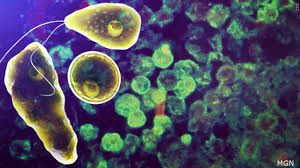Aleena Gul
Brain-eating amoeba, scientifically known as Naegleria fowleri, is the parasitic specie of
the genus Naegleria. About 30 different species of Naegleria have been found, but only
N. fowleri can cause infection in humans. It is known to cause amoebic meningoencephalitis (PAM). The first-ever case of this disease was reported in Australia in 1965. In Pakistan, the first case was reported in 2008 in Karachi. Numerous
cases of amoebic meningoencephalitis (PAM) have been reported in Pakistan as well as around the world, especially in countries like India, Japan, Australia, China, and New Zealand. The death rate of this disease is approximately 95%. It is most commonly
found in warm freshwater habitats like lakes, rivers, swimming pools, etc. Naegleria fowleri enters the human body while doing human activities in freshwater, i.e., swimming and diving. Brain-eating amoeba enters the nasal cavity and then attaches to
the nasal mucosa. It moves along the olfactory nerve through the cribriform plate until it reaches the central nervous system. The N. fowleri changes from cyst (dormant form) to trophozoite (active form). The trophozoites feed on brain tissues by phagocytosis or by releasing different nzymes, i.e., proteases and hydrolases. N. fowleri inhibits the action of the immune
system by changing its surface proteins and by producing antioxidant enzymes. Hence,
it results in the onset of infection.Amoebic meningoencephalitis (PAM) causes nerve injury in the CNS, which ultimately
leads to death due to the swelling and necrosis of brain tissues. Symptoms of this disease appear 2–8 days after coming into contact with the parasite. Severe headache, stiffness in the neck, high temperature (more than 100 °C), chills, seizures, confusion
and coma are the most common symptoms of amoebic meningoencephalitis. Clinical signs of this disease include lethargy, irregular heartbeats
and vomiting. It can also lead to hemorrhage if the infection is prolonged. The severity of the infections depends upon the capacity of the N. fowleri to enter the central nervous system (CNS) of the human body and cause the destruction of nasal passage and brain tissues. It results in the death of the patient within 1-2 weeks after exposure to the
infection.
Amoebic meningoencephalitis (PAM) is caused by a protist parasite, most commonly known as the brain-eating amoeba. This disease is caused by performing different human activities in warm fresh water. Swimmers and divers are more susceptible to this
disease. It can also be caused by interacting with non-chlorinated water in swimming pools. Untreated water from hot springs can also be contaminated with brain-eating amoeba. Contaminated tap water can also contribute to the onset of the infection. PAM
is not caused by drinking contaminated water; it is caused when N. fowleri reaches the olfactory nerve or nasal passage.The color of the cerebrospinal fluid changes from gray to red in the later stages of the disease. The presence of trophozoites can be checked by using trichrome or Giemsa stain. A CSF wet mount can also be analyzed using a microscope to confirm the presence of trophozoites. Molecular methods like PCR and ELIZA can also be used to identify certain genotypes, so we can
use these techniques for the diagnosis of N. fowleri. CT and MR imaging can reveal the signs of meningeal enhancement.
Primary amoebic meningoencephalitis (PAM), which is caused by Naegleria fowleri, has a fatality rate that exceeds 95% even with current amphotericin B treatment. Amphotericin B is the most commonly used medication; nevertheless, despite its
widespread usage and support from in vitro research and case reports, it has serious side effects including renal damage. There has been variable effectiveness with other therapies including azithromycin, miltefosine, fluconazole, miconazole, and rifampin.
Clinical trials are hindered by the rarity of infections. Corifungin has produced encouraging outcomes in animal models, while miltefosine has demonstrated potential, with two survivors in 2013. Because of their exceptional CNS penetration, fluconazole
and amphotericin B can work together to fight infection.
Seawater or chlorinated habitats are preferable over freshwater bodies such as lakes,rivers, and ponds in warm areas to lower the risk of infection with Naegleria fowleri. To stop amoeba from entering the nasal passages during freshwater activities, do not
submerge the head or splash water.
People can use nasal clips to prevent water from entering the nose. Using purified or distilled water to rinse the nose can prove effective to preventing this deadly disease.
The Sindh Health Department has issued advisory directions to different departments to ensure the proper chlorination of water according to the standards of World Health Organization (WHO).
Writer is a student of BS Biotechnology (6th semester) in Capital University of Science and Technology, Islamabad.



